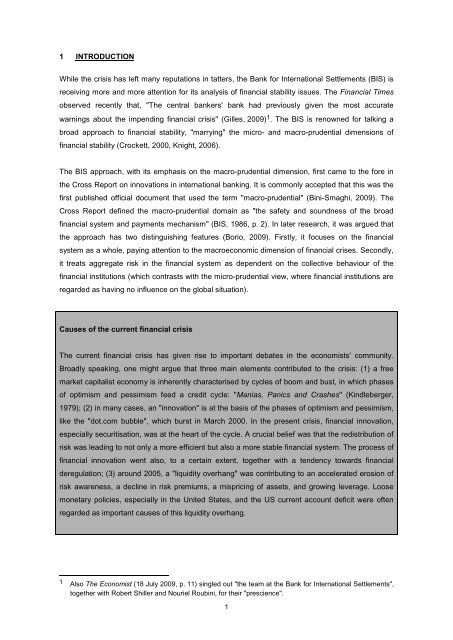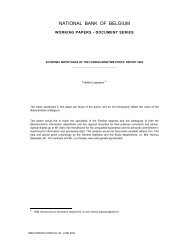Working Paper Research - Nationale Bank van België
Working Paper Research - Nationale Bank van België
Working Paper Research - Nationale Bank van België
You also want an ePaper? Increase the reach of your titles
YUMPU automatically turns print PDFs into web optimized ePapers that Google loves.
1 INTRODUCTIONWhile the crisis has left many reputations in tatters, the <strong>Bank</strong> for International Settlements (BIS) isreceiving more and more attention for its analysis of financial stability issues. The Financial Timesobserved recently that, "The central bankers' bank had previously given the most accuratewarnings about the impending financial crisis" (Gilles, 2009) 1 . The BIS is renowned for talking abroad approach to financial stability, "marrying" the micro- and macro-prudential dimensions offinancial stability (Crockett, 2000, Knight, 2006).The BIS approach, with its emphasis on the macro-prudential dimension, first came to the fore inthe Cross Report on innovations in international banking. It is commonly accepted that this was thefirst published official document that used the term "macro-prudential" (Bini-Smaghi, 2009). TheCross Report defined the macro-prudential domain as "the safety and soundness of the broadfinancial system and payments mechanism" (BIS, 1986, p. 2). In later research, it was argued thatthe approach has two distinguishing features (Borio, 2009). Firstly, it focuses on the financialsystem as a whole, paying attention to the macroeconomic dimension of financial crises. Secondly,it treats aggregate risk in the financial system as dependent on the collective behaviour of thefinancial institutions (which contrasts with the micro-prudential view, where financial institutions areregarded as having no influence on the global situation).Causes of the current financial crisisThe current financial crisis has given rise to important debates in the economists' community.Broadly speaking, one might argue that three main elements contributed to the crisis: (1) a freemarket capitalist economy is inherently characterised by cycles of boom and bust, in which phasesof optimism and pessimism feed a credit cycle: "Manias, Panics and Crashes" (Kindleberger,1979); (2) in many cases, an "innovation" is at the basis of the phases of optimism and pessimism,like the "dot.com bubble", which burst in March 2000. In the present crisis, financial innovation,especially securitisation, was at the heart of the cycle. A crucial belief was that the redistribution ofrisk was leading to not only a more efficient but also a more stable financial system. The process offinancial innovation went also, to a certain extent, together with a tendency towards financialderegulation; (3) around 2005, a "liquidity overhang" was contributing to an accelerated erosion ofrisk awareness, a decline in risk premiums, a mispricing of assets, and growing leverage. Loosemonetary policies, especially in the United States, and the US current account deficit were oftenregarded as important causes of this liquidity overhang.1 Also The Economist (18 July 2009, p. 11) singled out "the team at the <strong>Bank</strong> for International Settlements",together with Robert Shiller and Nouriel Roubini, for their "prescience".1
















